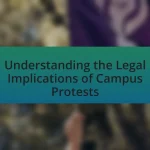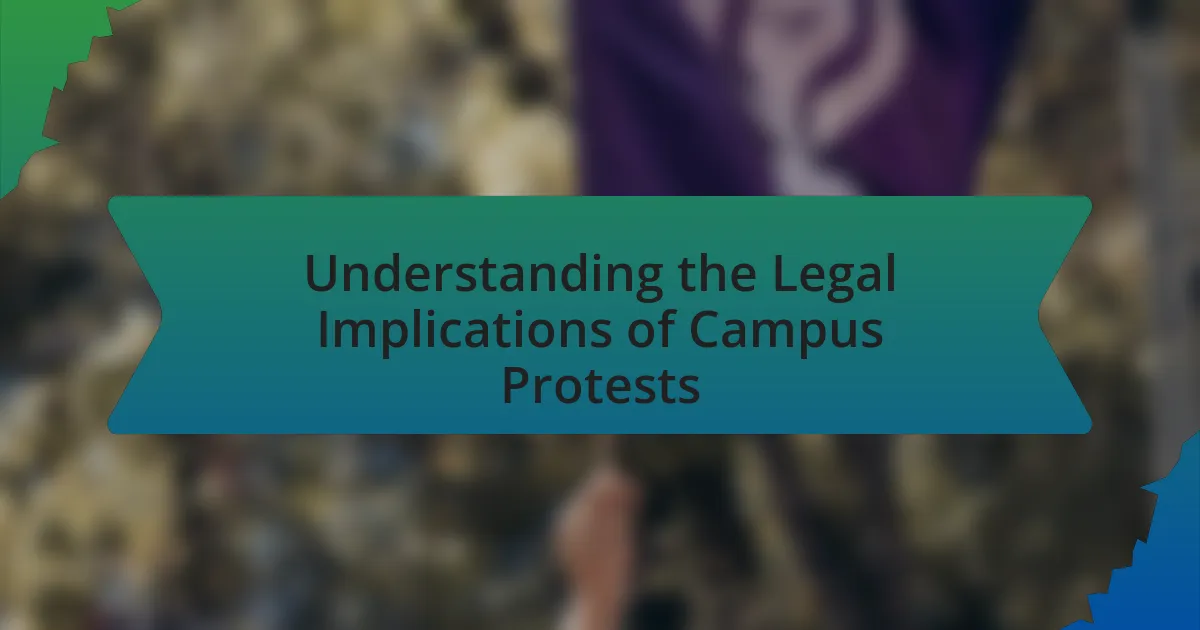The article examines the critical role of intersectional politics in campus movements, emphasizing how interconnected social identities such as race, gender, and class contribute to unique experiences of oppression. It discusses the influence of intersectionality on campus activism, highlighting key principles and historical contexts that shape contemporary movements. The article also explores the challenges faced by campus movements lacking an intersectional approach, the importance of solidarity among diverse groups, and the impact of prominent activists in advancing intersectional politics. Additionally, it outlines strategies for incorporating intersectional frameworks into activism and the successes achieved through these efforts, ultimately advocating for inclusive practices that address systemic inequalities within educational institutions.
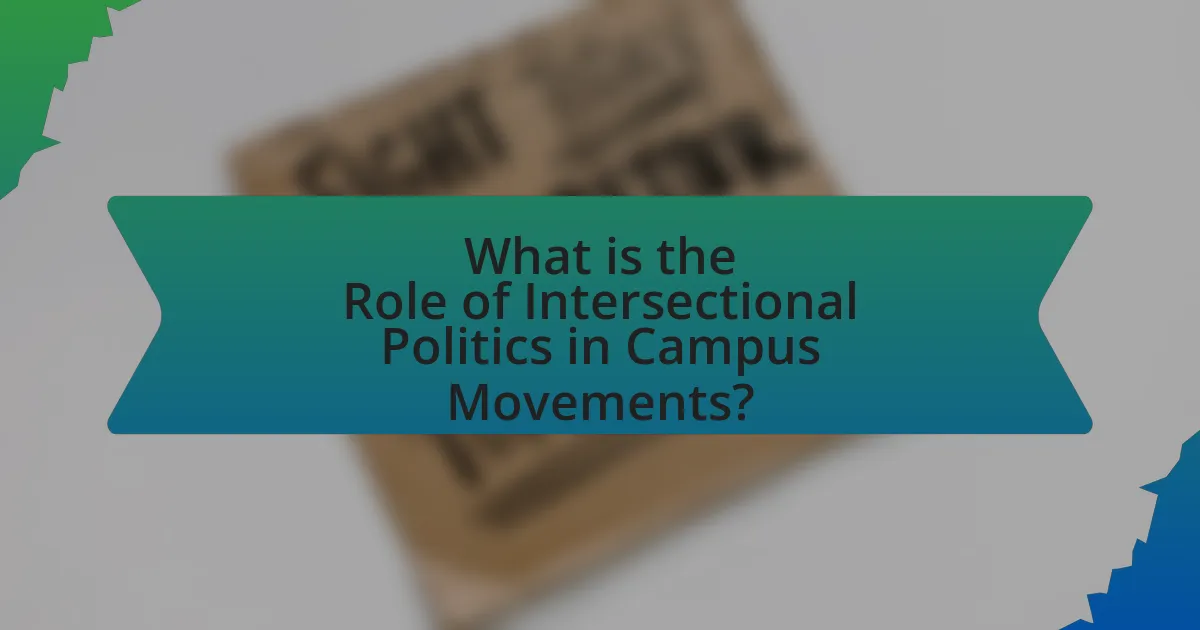
What is the Role of Intersectional Politics in Campus Movements?
Intersectional politics play a crucial role in campus movements by addressing the interconnected nature of social categorizations such as race, gender, and class, which can create overlapping systems of discrimination or disadvantage. This approach allows campus movements to advocate for a more inclusive and equitable environment by recognizing that individuals experience oppression differently based on their multiple identities. For instance, the Black Lives Matter movement on campuses has highlighted how racial injustice intersects with issues of gender and sexuality, leading to a broader coalition of support and activism. Research shows that intersectional frameworks can enhance the effectiveness of social movements by fostering solidarity among diverse groups, as evidenced by the increased participation and engagement in movements that explicitly incorporate intersectional perspectives.
How does intersectionality influence campus activism?
Intersectionality influences campus activism by highlighting the interconnected nature of social identities and systemic inequalities, which allows activists to address multiple forms of oppression simultaneously. This approach fosters a more inclusive and comprehensive understanding of issues such as race, gender, sexuality, and class, enabling activists to create strategies that resonate with diverse student populations. For instance, research by Crenshaw (1989) introduced the concept of intersectionality, demonstrating how individuals with overlapping marginalized identities face unique challenges that are often overlooked in traditional activism. By applying intersectional frameworks, campus movements can better advocate for policies and practices that reflect the needs of all students, ultimately leading to more effective and equitable outcomes in social justice efforts.
What are the key principles of intersectional politics?
The key principles of intersectional politics include recognizing the interconnectedness of social identities and the ways in which they shape individual experiences of oppression and privilege. Intersectional politics emphasizes that factors such as race, gender, sexuality, class, and ability do not exist in isolation but interact to create unique social dynamics. This framework was notably articulated by Kimberlé Crenshaw, who highlighted that traditional approaches to social justice often overlook the complexities faced by individuals with multiple marginalized identities. By applying an intersectional lens, activists and policymakers can better address systemic inequalities and advocate for more inclusive solutions that reflect the diverse experiences of all individuals within campus movements.
How do these principles manifest in campus movements?
Intersectional politics manifest in campus movements through the active engagement of diverse student groups advocating for social justice, equity, and inclusion. These movements often highlight the interconnectedness of various identities, such as race, gender, sexuality, and socioeconomic status, leading to initiatives that address multiple forms of discrimination. For example, the Black Lives Matter movement on campuses has galvanized students to confront systemic racism while also advocating for the rights of individuals and women, demonstrating how intersectionality informs their activism. Research by Crenshaw (1989) emphasizes that understanding these overlapping identities is crucial for effective advocacy, as it allows movements to address the unique challenges faced by marginalized groups within the broader struggle for justice.
Why is understanding intersectional politics important for campus movements?
Understanding intersectional politics is crucial for campus movements because it allows activists to address the diverse and overlapping identities that shape individuals’ experiences of oppression and privilege. By recognizing how factors such as race, gender, sexuality, and socioeconomic status intersect, campus movements can create more inclusive strategies that resonate with a broader range of students. Research by Crenshaw (1989) highlights that failing to consider these intersections can lead to the marginalization of certain groups within social justice efforts, ultimately weakening the movement’s effectiveness. Therefore, a nuanced understanding of intersectional politics enhances solidarity and fosters a more equitable environment on campuses.
What challenges do campus movements face without an intersectional approach?
Campus movements face significant challenges without an intersectional approach, primarily the risk of marginalizing voices and issues that do not align with the dominant narratives. This lack of inclusivity can lead to a failure in addressing the diverse needs of all community members, resulting in ineffective advocacy and limited impact. For instance, movements that focus solely on one aspect of identity, such as race or gender, may overlook how these identities intersect with other factors like socioeconomic status or disability, thereby alienating potential allies and supporters. Research indicates that movements lacking intersectionality often struggle to mobilize broader coalitions, as they do not resonate with the varied experiences of individuals within the community, ultimately hindering their effectiveness and sustainability.
How can intersectional politics enhance solidarity among diverse groups?
Intersectional politics enhances solidarity among diverse groups by recognizing and addressing the interconnected nature of social identities and systemic inequalities. This approach fosters collaboration by highlighting shared struggles and experiences, allowing groups to unite around common goals. For instance, research by Crenshaw (1989) emphasizes that understanding the overlapping identities of race, gender, and class can lead to more effective advocacy and support networks. By acknowledging these complexities, intersectional politics encourages empathy and collective action, ultimately strengthening alliances among marginalized communities.
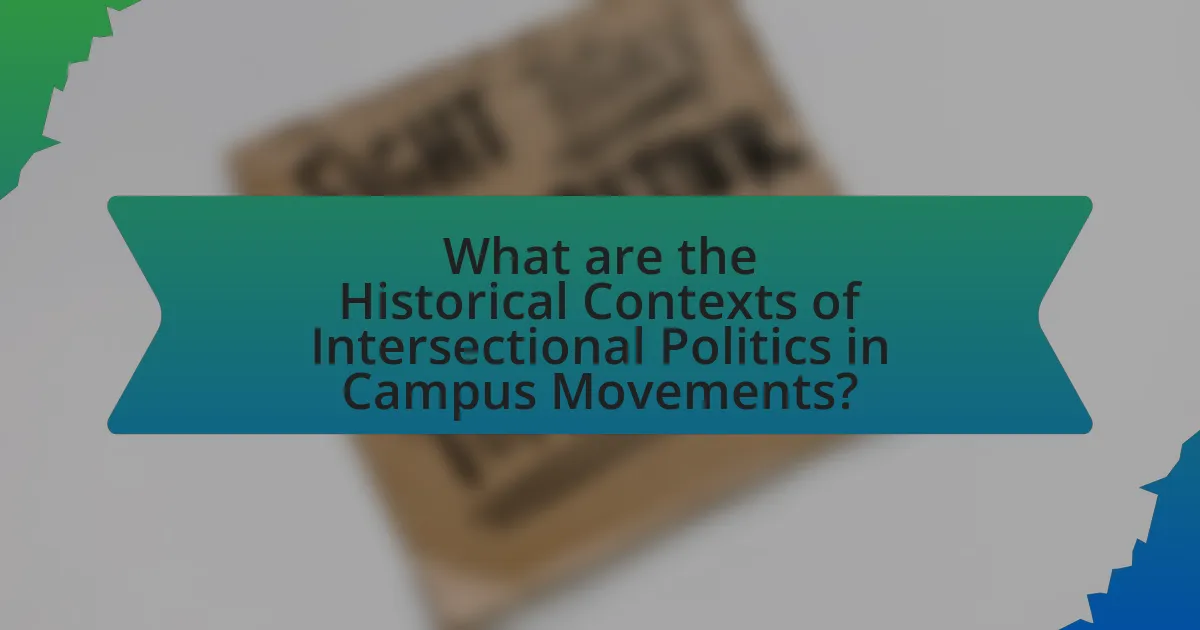
What are the Historical Contexts of Intersectional Politics in Campus Movements?
The historical contexts of intersectional politics in campus movements are rooted in the civil rights movements of the 1960s and 1970s, which highlighted the interconnectedness of race, gender, and class. These movements laid the groundwork for recognizing that social identities do not exist in isolation; rather, they intersect to shape individuals’ experiences of oppression and privilege. For instance, the Combahee River Collective, formed in 1974, emphasized the importance of addressing the unique struggles faced by Black women, thus illustrating the need for an intersectional approach in activism. This framework has since evolved, influencing contemporary campus movements that advocate for social justice, equity, and inclusion, as seen in initiatives like Black Lives Matter and the fight for rights on college campuses. The historical significance of these movements underscores the necessity of intersectionality in understanding and addressing systemic inequalities within educational institutions.
How have past campus movements shaped current intersectional politics?
Past campus movements have significantly shaped current intersectional politics by establishing frameworks for collective action that address multiple social identities and injustices. For instance, the civil rights movement of the 1960s on college campuses laid the groundwork for recognizing the interconnectedness of race, gender, and class in political activism. This historical context is evident in the formation of organizations like the Black Student Union, which advocated for the inclusion of diverse voices in university governance and curriculum. Additionally, the feminist movements of the 1970s and activism in the 1980s further emphasized the importance of intersectionality, leading to a broader understanding of how various forms of oppression overlap. These movements have influenced contemporary activism, as seen in the rise of coalitions that unite different marginalized groups to address systemic inequalities, demonstrating the lasting impact of past campus movements on today’s intersectional political landscape.
What significant events in history highlight intersectional activism on campuses?
Significant events in history that highlight intersectional activism on campuses include the 1969 Stonewall Riots, which galvanized rights alongside racial and gender equality movements, and the 2015 Black Lives Matter protests, which emphasized the interconnectedness of racial justice and other social issues. The Stonewall Riots marked a pivotal moment in activism, leading to increased visibility and advocacy for marginalized communities on college campuses. Similarly, the Black Lives Matter movement prompted students to address systemic racism while also advocating for issues such as gender equality and economic justice, showcasing the importance of intersectionality in contemporary activism. These events illustrate how campus movements have historically intertwined various social justice issues, fostering a more inclusive approach to activism.
How have different social movements influenced campus intersectionality?
Different social movements have significantly influenced campus intersectionality by promoting awareness and advocacy for diverse identities and experiences. Movements such as Black Lives Matter, rights, and feminist activism have highlighted the interconnectedness of race, gender, sexuality, and class, leading to more inclusive policies and practices on campuses. For instance, the rise of intersectional feminism has encouraged universities to address issues like sexual violence and discrimination through a lens that considers multiple identities, resulting in the implementation of comprehensive support systems for marginalized students. This shift is evidenced by the increasing number of campus organizations and initiatives that focus on intersectional issues, reflecting a broader societal recognition of the importance of diversity and inclusion in educational environments.
What role do key figures play in the evolution of intersectional politics on campuses?
Key figures play a crucial role in the evolution of intersectional politics on campuses by serving as catalysts for awareness and change. These individuals, often student leaders, activists, or faculty members, mobilize communities around issues that intersect various identities, such as race, gender, and socioeconomic status. For instance, the emergence of organizations like Black Lives Matter on campuses has highlighted the importance of intersectionality in addressing systemic injustices, fostering dialogue and activism that incorporates diverse perspectives. Their influence is evidenced by increased participation in intersectional initiatives, as seen in the rise of coalitions that unite different student groups to advocate for comprehensive policy changes, reflecting a broader understanding of social justice.
Who are the prominent activists advocating for intersectionality in campus movements?
Prominent activists advocating for intersectionality in campus movements include Kimberlé Crenshaw, who coined the term “intersectionality,” and has been influential in shaping discussions around race, gender, and class in academic settings. Additionally, activists like Alicia Garza, co-founder of the Black Lives Matter movement, and Angela Davis, a long-time advocate for social justice, have also played significant roles in promoting intersectional approaches on campuses. Their work emphasizes the interconnectedness of various social identities and injustices, which is crucial for understanding and addressing systemic inequalities in educational environments.
What impact have these figures had on student engagement and activism?
These figures have significantly increased student engagement and activism by providing relatable role models and amplifying marginalized voices. Their visibility and advocacy have inspired students to mobilize around issues such as racial justice, gender equality, and climate change, leading to higher participation in protests and campus organizations. For instance, the rise of social media has allowed these figures to reach a broader audience, resulting in movements like Black Lives Matter gaining traction on campuses nationwide, which has been documented in studies showing increased student activism in response to high-profile incidents of injustice.
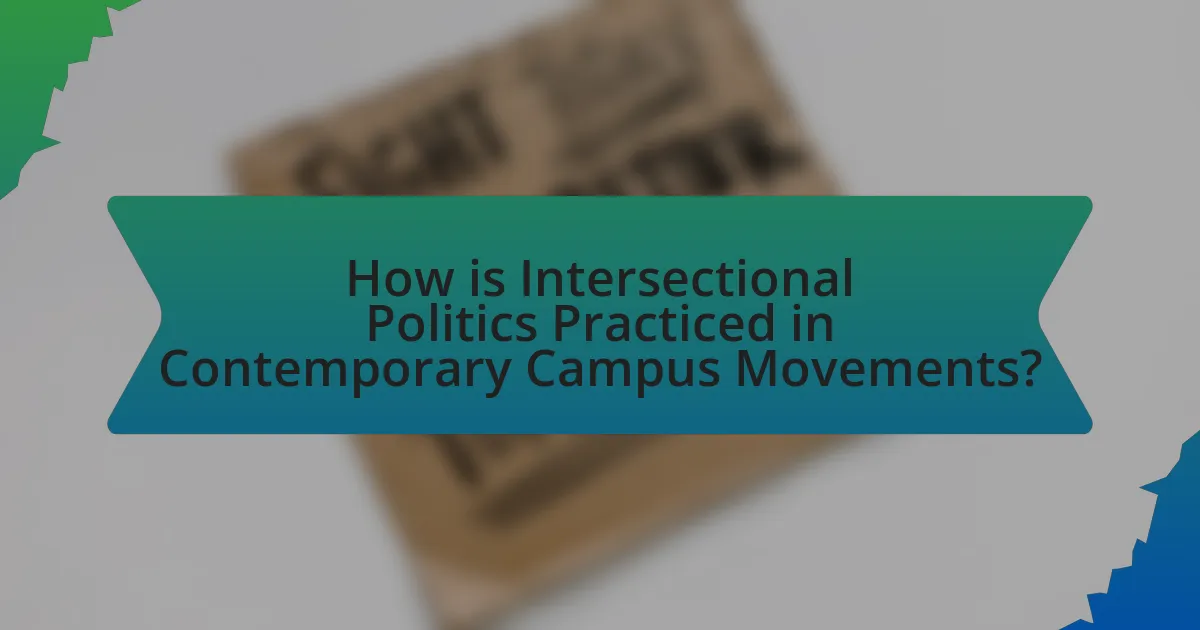
How is Intersectional Politics Practiced in Contemporary Campus Movements?
Intersectional politics in contemporary campus movements is practiced through the active collaboration of diverse student groups that address multiple forms of oppression, such as race, gender, sexuality, and class. These movements often organize events, workshops, and campaigns that highlight the interconnectedness of various social justice issues, fostering an inclusive environment where marginalized voices are amplified. For instance, the Black Lives Matter movement on campuses has intersected with feminist and advocacy, demonstrating solidarity across different identities and experiences. This approach not only broadens the scope of activism but also enhances the effectiveness of campaigns by recognizing and addressing the complexities of individual experiences within systemic structures of power.
What strategies do campus movements use to incorporate intersectional politics?
Campus movements incorporate intersectional politics through strategies such as coalition-building, inclusive programming, and advocacy for policy changes that address multiple forms of oppression. Coalition-building allows diverse groups to unite around shared goals, amplifying voices that represent various identities, such as race, gender, and sexuality. Inclusive programming ensures that events and initiatives reflect the experiences of marginalized communities, fostering a sense of belonging and engagement. Additionally, advocacy for policy changes targets systemic inequalities, pushing institutions to adopt practices that recognize and address the complexities of intersectionality. These strategies are supported by research indicating that intersectional approaches enhance the effectiveness of social movements by creating more comprehensive and representative agendas.
How do coalitions form among different student groups to promote intersectionality?
Coalitions form among different student groups to promote intersectionality through collaborative efforts that emphasize shared goals and mutual support. These coalitions often arise when diverse student organizations recognize overlapping issues, such as racial, gender, and socioeconomic inequalities, prompting them to unite for collective advocacy. For instance, student groups representing marginalized communities may come together to address systemic discrimination on campus, leveraging their unique perspectives to create a more inclusive environment. Research indicates that such coalitions can enhance the effectiveness of advocacy efforts, as seen in the 2015 Black Lives Matter movement on college campuses, where various student organizations collaborated to address racial injustice, demonstrating the power of intersectional solidarity in achieving common objectives.
What role does social media play in advancing intersectional campus movements?
Social media plays a crucial role in advancing intersectional campus movements by facilitating communication, mobilization, and awareness among diverse student groups. It allows for the rapid dissemination of information regarding social justice issues, enabling students to organize events, share resources, and amplify marginalized voices. For instance, platforms like Twitter and Instagram have been instrumental in campaigns such as #BlackLivesMatter and #MeToo, which have gained significant traction on college campuses, fostering solidarity among various intersectional identities. Research indicates that social media engagement increases participation in activism, as seen in a study published in the Journal of Youth Studies, which found that 70% of young activists reported using social media to connect with others and mobilize for causes. This demonstrates that social media not only enhances visibility for intersectional issues but also strengthens community ties and collective action among students.
What are the outcomes of applying intersectional politics in campus activism?
Applying intersectional politics in campus activism leads to more inclusive and effective movements that address the diverse needs of marginalized groups. This approach recognizes the interconnected nature of social identities, such as race, gender, sexuality, and class, allowing activists to develop strategies that consider multiple forms of oppression. Research indicates that intersectional activism fosters solidarity among different groups, enhances awareness of systemic inequalities, and promotes policies that benefit a broader range of individuals. For instance, a study by Crenshaw (1989) highlights how intersectionality can reveal the unique challenges faced by Black women, which are often overlooked in traditional feminist and anti-racist discourses. Thus, the outcomes of applying intersectional politics include increased representation, improved coalition-building, and more comprehensive solutions to social justice issues on campuses.
How do intersectional approaches affect policy changes on campuses?
Intersectional approaches significantly influence policy changes on campuses by highlighting the interconnectedness of various social identities and systemic inequalities. These approaches encourage institutions to consider how race, gender, sexuality, and class intersect, leading to more inclusive and equitable policies. For example, research from the University of California, Berkeley, demonstrates that intersectional frameworks have led to the implementation of comprehensive anti-discrimination policies that address multiple forms of bias simultaneously, rather than in isolation. This shift not only fosters a more inclusive campus environment but also aligns institutional practices with the diverse needs of the student body, ultimately resulting in more effective and responsive policy changes.
What successes have been achieved through intersectional campus movements?
Intersectional campus movements have achieved significant successes, including the implementation of more inclusive policies and the establishment of support systems for marginalized groups. For instance, many universities have adopted comprehensive diversity and inclusion initiatives that address the needs of students from various racial, gender, and socioeconomic backgrounds. A notable example is the creation of resource centers dedicated to students, students of color, and first-generation college students, which provide tailored support and advocacy. Additionally, intersectional movements have successfully influenced curriculum changes, leading to the incorporation of diverse perspectives in academic programs, as seen in the increased offerings of courses on race, gender, and sexuality studies across numerous institutions. These achievements demonstrate the tangible impact of intersectional activism in fostering a more equitable campus environment.
What best practices can enhance the effectiveness of intersectional politics in campus movements?
To enhance the effectiveness of intersectional politics in campus movements, it is essential to prioritize inclusive representation and active collaboration among diverse groups. Inclusive representation ensures that voices from various identities—such as race, gender, sexuality, and socioeconomic status—are heard and valued, which fosters a more comprehensive understanding of issues affecting marginalized communities. Active collaboration among these groups can lead to the development of strategies that address the interconnected nature of social injustices, as evidenced by successful campus coalitions that have tackled issues like racial inequality and gender-based violence simultaneously. Research indicates that movements that embrace intersectionality are more likely to achieve sustainable change, as they address the root causes of oppression rather than isolated symptoms.
How can student organizations foster inclusive environments for all identities?
Student organizations can foster inclusive environments for all identities by implementing policies and practices that prioritize diversity, equity, and inclusion. These organizations should actively recruit members from various backgrounds, ensuring representation across different identities, including race, gender, sexual orientation, and ability. Research indicates that diverse groups enhance creativity and problem-solving, as seen in a study by Page (2007) in “The Difference: How the Power of Diversity Creates Better Groups, Firms, Schools, and Societies,” which highlights that diverse teams outperform homogeneous ones in complex tasks. Additionally, student organizations can provide training on cultural competency and allyship, creating a safe space for dialogue and understanding. By hosting events that celebrate various cultures and identities, organizations can promote awareness and appreciation, further solidifying an inclusive atmosphere.
What resources are available to support intersectional activism on campuses?
Resources available to support intersectional activism on campuses include student organizations, workshops, funding opportunities, and academic programs. Student organizations such as the Black Student Union or Alliance provide platforms for advocacy and community building. Workshops on topics like privilege, allyship, and social justice equip students with the skills needed for effective activism. Funding opportunities from university grants or external organizations help finance events and initiatives that promote intersectional causes. Additionally, academic programs focusing on gender studies, ethnic studies, or social justice provide theoretical frameworks and research support for intersectional activism, enhancing students’ understanding and engagement in these movements.

